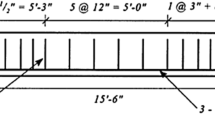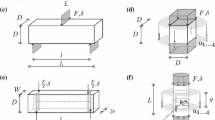Abstract
This paper discusses the identification and characterization of material parameters of a concrete damage plasticity constitutive model that is used to describe the mechanical responses of mortar, bricks, and concrete, defined here as the three material components of an unreinforced masonry infill wall system. Each of these material components exhibits a nonlinear and inelastic response, which it is hypothesized can be fully described by the use of a single concrete damage plasticity material model. A comprehensive investigation of experimental tests on these materials found in the literature showed large variations in their stress–strain mechanical responses when subjected to uniaxial compression loading. This may be attributed to different factors, including material properties, manufacturing, and geometry of the testing specimens. This work focuses on the study of material properties of mortar, bricks, and concrete, with the objective of retrieving optimal model parameters using a quasi-brittle constitutive model. For this purpose, a set of numerical experiments are designed and implemented reproducing standard uniaxial compression tests on each material. The methodology to explore the use of the proposed constitutive model includes a parametric analysis, followed by the deterministic calibration of the model parameters based on a standard optimization approach.











Similar content being viewed by others
References
Lotfi H, Shing P (1991) An appraisal of smeared crack models for masonry shear wall analysis. Comput Struct 41(3):413–425. https://doi.org/10.1016/0045-7949(91)90134-8
Grassl P, Jirásek M (2006) Damage-plastic model for concrete failure. Int J Solids Struct 43(22–23):7166–7196. https://doi.org/10.1016/j.ijsolstr.2006.06.032
Lubliner J (1991) A simple model of generalized plasticity. Int J Solids Struct 28(6):769–778. https://doi.org/10.1016/0020-7683(91)90155-9
Lubliner J, Oliver J, Oller S, Oñate E (1989) A plastic-damage model for concrete. Int J Solids Struct 25(3):299–326. https://doi.org/10.1016/0020-7683(89)90050-4
Gambarotta L, Lagomarsino S (1997) Damage models for the seismic response of brick masonry shear walls. Part I: the mortar joint model and its applications. Earthq Eng Struct Dyn 26(4):423–439
Lee J, Fenves GL (1998) Plastic-damage model for cyclic loading of concrete structures. J Eng Mech 124(8):892–900. https://doi.org/10.1061/(ASCE)0733-9399(1998)124:8(892)
Kmiecik P, Kamiński M (2011) Modelling of reinforced concrete structures and composite structures with concrete strength degradation taken into consideration. Arch Civil Mech Eng 11(3):623–636. https://doi.org/10.1016/S1644-9665(12)60105-8
Jankowiak T, Lodygowski T (2005) Identification of parameters of concrete damage plasticity constitutive model. Found Civil Environ Eng 6(1):53–69. https://doi.org/10.1016/j.proeng.2017.02.068
Morbiducci R (2003) Nonlinear parameter identification of models for masonry. Int J Solids Struct 40(15):4071–4090. https://doi.org/10.1016/S0020-7683(03)00170-7
Cecchi A, Sab K (2002) A multi-parameter homogenization study for modeling elastic masonry. Eur J Mech-A/Solids 21(2):249–268. https://doi.org/10.1016/S0997-7538(01)01195-0
Sarhosis V, Sheng Y (2014) Identification of material parameters for low bond strength masonry. Eng Struct 60:100–110. https://doi.org/10.1016/j.engstruct.2013.12.013
Morbiducci R, Shing P (1998) Parameter identification of a nonlinear interface model for masonry mortar joints. Inverse problems in engineering mechanics. Elsevier, Amsterdam, pp 273–282. https://doi.org/10.1016/B978-008043319-6/50032-7
Chisari C, Macorini L, Amadio C, Izzuddin BA (2018) Identification of mesoscale model parameters for brick-masonry. Int J Solids Struct 146:224–240. https://doi.org/10.1016/j.ijsolstr.2018.04.003
Rechea C, Levasseur S, Finno R (2008) Inverse analysis techniques for parameter identification in simulation of excavation support systems. Comput Geotech 35(3):331–345. https://doi.org/10.1016/j.compgeo.2007.08.008
Chisari C (2015) Inverse techniques for model identification of masonry structures. http://hdl.handle.net/10077/11123
Chisari C, Macorini L, Amadio C, Izzuddin B (2015) An inverse analysis procedure for material parameter identification of mortar joints in unreinforced masonry. Comput Struct 155:97–105. https://doi.org/10.1016/j.compstruc.2015.02.008
Chisari C (2019) Tolerance-based Pareto optimality for structural identification accounting for uncertainty. Eng Comput 35(2):381–395. https://doi.org/10.1007/s00366-018-0605-7
Fadale TD, Nenarokomov AV, Emery AF (1995) Uncertainties in parameter estimation: the inverse problem. Int J Heat Mass Transf 38(3):511–518. https://doi.org/10.1016/0017-9310(94)00175-U
Carmeliet J (1999) Optimal estimation of gradient damage parameters from localization phenomena in quasi-brittle materials. Mech Cohes-Frict Mater: An Int J Exp, Model Comput Mater Struct 4(1):1–16
Muñoz-Rojas P, Cardoso E, Vaz M (2010) Parameter identification of damage models using genetic algorithms. Exp Mech 50(5):627–634. https://doi.org/10.1007/s11340-009-9321-y
Nazari A, Sanjayan JG (2015) Modelling of compressive strength of geopolymer paste, mortar and concrete by optimized support vector machine. Ceram Int 41(9):12164–12177. https://doi.org/10.1016/j.ceramint.2015.06.037
Toropov VV, van der Giessen E (1993) Parameter identification for nonlinear constitutive models: Finite Element simulation—Optimization—Nontrivial experiments. Optimal design with advanced materials. Elsevier, Amsterdam, pp 113–130
Macorini L, Izzuddin BA (2011) A non-linear interface element for 3D mesoscale analysis of brick-masonry structures. Int J Numer Meth Eng 85(12):1584–1608. https://doi.org/10.1002/nme.3046
Petracca M, Pelà L, Rossi R, Zaghi S, Camata G, Spacone E (2017) Micro-scale continuous and discrete numerical models for nonlinear analysis of masonry shear walls. Constr Build Mater 15(149):296–314. https://doi.org/10.1016/j.conbuildmat.2017.05.130
Pantò B, Cannizzaro F, Caliò I, Lourenço PB (2017) Numerical and experimental validation of a 3D macro-model for the in-plane and out-of-plane behavior of unreinforced masonry walls. Int J Arch Herit 11(7):946–964. https://doi.org/10.1080/15583058.2017.1325539
Casolo S, Milani G (2010) A simplified homogenization-discrete element model for the non-linear static analysis of masonry walls out-of-plane loaded. Eng Struct 32(8):2352–2366. https://doi.org/10.1016/j.engstruct.2010.04.010
Di Trapani F, Shing PB, Cavaleri L (2018) Macroelement model for in-plane and out-of-plane responses of masonry infills in frame structures. J Struct Eng 144(2):04017198. https://doi.org/10.1061/(ASCE)ST.1943-541X.0001926.©
Simulia D (2016) Abaqus Version 2016 Documentation USA. Dassault Systems Simulia Corp, Johnston, RI, USA
Hillerborg A, Modéer M, Petersson P-E (1976) Analysis of crack formation and crack growth in concrete by means of fracture mechanics and finite elements. Cem Concr Res 6(6):773–781. https://doi.org/10.1016/0008-8846(76)90007-7
Blackard B, Kim B, Citto C, Willam K, Mettupalayam S (2007) Failure issues of brick masonry. In: Proceedings of the Sixth International Conference on Fracture Mechanics of Concrete and Concrete Structures. pp 1587–1594
Mehrabi AB (1996) Behavior of masonry infilled reinforced concrete frames subjected to lateral loadings.
McNary WS, Abrams DP (1985) Mechanics of masonry in compression. J Struct Eng 111(4):857–870. https://doi.org/10.1061/(ASCE)0733-9445(1985)111:4(857)
Illampas R, Ioannou I, Charmpis DC (2014) Adobe bricks under compression: experimental investigation and derivation of stress–strain equation. Constr Build Mater 53:83–90. https://doi.org/10.1016/j.conbuildmat.2013.11.103
Singh S, Munjal P (2017) Bond strength and compressive stress-strain characteristics of brick masonry. J Build Eng 9:10–16. https://doi.org/10.1016/j.jobe.2016.11.006
Barbosa C, Lourenço PB, Mohamad G, Hanai J (2007) Triaxial compression tests on bedding mortar samples looking at confinement effect analysis.
Kaushik HB, Rai DC, Jain SK (2007) Stress-strain characteristics of clay brick masonry under uniaxial compression. J Mater Civ Eng 19(9):728–739. https://doi.org/10.1061/(ASCE)0899-1561(2007)19:9(728)
Venkatarama Reddy B, Gupta A (2006) Strength and elastic properties of stabilized mud block masonry using cement-soil mortars. J Mater Civ Eng 18(3):472–476. https://doi.org/10.1061/(ASCE)0899-1561(2006)18:3(472)
Barbosa CS, Lourenço PB, Hanai JB (2010) On the compressive strength prediction for concrete masonry prisms. Mater Struct 43(3):331–344. https://doi.org/10.1617/s11527-009-9492-0
Nguyen L (2014) Confined Masonry: Theoretical fundamentals, experimental test, finite element models, and future uses. University of Colorado at Boulder, CRC Press, USA
Mohamad G, Lourenço PB, Roman HR (2006) Poisson behaviour of bedding mortar under multiaxial stress state.
Ciornei L (2012) Performance of polyurea retrofitted unreinforced concrete masonry walls under blast loading. University of Ottawa (Canada), https://doi.org/10.20381/RUOR-5935
Fiorato AE, Sozen MA, Gamble WL (1970) An investigation of the interaction of reinforced concrete frames with masonry filler walls. University of Illinois Engineering Experiment Station. College of Engineering. University of Illinois at Urbana-Champaign., http://hdl.handle.net/2142/14303
Xavier B, Francisco H (2015) The role of masonry infill in progressive collapse mitigation of multi-storey buildings. https://doi.org/10.25560/43154
Gonçalves J, Tavares L, Toledo Filho R, Fairbairn E, Cunha E (2007) Comparison of natural and manufactured fine aggregates in cement mortars. Cem Concr Res 37(6):924–932. https://doi.org/10.1016/j.cemconres.2007.03.009
Papazafeiropoulos G, Muñiz-Calvente M, Martínez-Pañeda E (2017) Abaqus2Matlab: a suitable tool for finite element post-processing. Adv Eng Softw 105:9–16. https://doi.org/10.1016/j.advengsoft.2017.01.006
Drysdale RG, Hamid AA, Baker LR (1994) Masonry structures: behavior and design.
Mosalam KMA (1996) Experimental and computational strategies for the seismic behavior evaluation of frames with infill walls. Cornell University
Crisafulli FJ (1997) Seismic behaviour of reinforced concrete structures with masonry infills. https://doi.org/10.26021/1979
Blackard B, Willam K, Mettupalayam S (2009) Experimental observations of masonry infilled reinforced concrete frames with openings. Special Publication 265:122–199
Stavridis A (2009) Analytical and experimental study of seismic performance of reinforced concrete frames infilled with masonry walls. UC San Diego, USA
Hognestad E, Hanson NW, McHenry D (1955) Concrete stress distribution in ultimate strength design. In: Journal Proceedings. vol 12. pp 455–480. https://doi.org/10.14359/11609
Desayi P, Krishnan S (1964) Equation for the stress-strain curve of concrete. In: Journal Proceedings. vol 3. pp 345–350
Smith G, Young L (1956) Ultimate flexural analysis based on stress-strain curves of cylinders. In: Journal Proceedings. vol 12. pp 597–609
Pramono E, Willam K (1989) Fracture energy-based plasticity formulation of plain concrete. J Eng Mech 115(6):1183–1204. https://doi.org/10.1061/(ASCE)0733-9399(1989)115:6(1183)
Grassl P (2004) Modelling of dilation of concrete and its effect in triaxial compression. Finite Elem Anal Des 40(9–10):1021–1033. https://doi.org/10.1016/j.finel.2003.04.002
Feenstra PH, De Borst R (1996) A composite plasticity model for concrete. Int J Solids Struct 33(5):707–730. https://doi.org/10.1016/0020-7683(95)00060-N
Chen AC, Chen W-F (1975) Constitutive relations for concrete. Journal of Engineering Mechanics 101 (ASCE# 11529 Proceeding). http://worldcat.org/issn/07339399
Grassl P, Xenos D, Nyström U, Rempling R, Gylltoft K (2013) CDPM2: A damage-plasticity approach to modelling the failure of concrete. Int J Solids Struct 50(24):3805–3816. https://doi.org/10.1016/j.ijsolstr.2013.07.008
Demin W, Fukang H (2017) Investigation for plastic damage constitutive models of the concrete material. Procedia Eng 210:71–78. https://doi.org/10.1016/j.proeng.2017.11.050
Karsan ID, Jirsa JO (1969) Behavior of concrete under compressive loadings. J Struct Div 95(12):2543–2564
Jenq Y, Shah SP (1985) Two parameter fracture model for concrete. J Eng Mech 111(10):1227–1241. https://doi.org/10.1061/(ASCE)0733-9399(1985)111:10(1227)
Philleo RE (1955) Comparison of results of three methods for determining young’s modulus of elasticity of concrete. In: Journal Proceedings. vol 1. pp 461–470. https://doi.org/10.14359/11690
Kolluru SV, Popovics JS, Shah SP (2000) Determining elastic properties of concrete using vibrational resonance frequencies of standard test cylinders. Cement, Concrete Aggr 22(2):81–89. https://doi.org/10.1520/CCA10467J
Hibbitt H, Karlsson B, Sorensen P (2011) Abaqus analysis user’s manual version 6.10. Dassault Systèmes Simulia Corp: Providence, RI, USA
Chen W-F, Han D-J (2007) Plasticity for structural engineers. J Ross Publ. https://doi.org/10.1007/978-1-4612-3864-5
Michał S, Andrzej W (2015) Calibration of the CDP model parameters in Abaqus. In: The 2015 World Congress on Advanced in Structural Engineering and Mechanics. https://doi.org/10.14359/4154.
Jirasek M, Bazant ZP (2002) Inelastic analysis of structures. John Wiley & Sons, USA
Khoo C-L (1972) A failure criterion for brickwork in axial compression. University of Edinburgh
Mohamad G, Fonseca FS, Roman HR, Vermeltfoort A, Rizzatti E (2015) Behavior of mortar under multitaxial stress. In: Proceedings of 12th North American Masonry Conference
Mohamad G, Fonseca FS, Vermeltfoort AT, Martens DR, Lourenço PB (2017) Strength, behavior, and failure mode of hollow concrete masonry constructed with mortars of different strengths. Constr Build Mater 134:489–496. https://doi.org/10.1016/j.conbuildmat.2016.12.112
Yang K-H, Lee Y, Hwang Y-H (2019) A Stress-Strain Model for Brick Prism under Uniaxial Compression. Adv Civil Eng. https://doi.org/10.1155/2019/7682575
Author information
Authors and Affiliations
Corresponding author
Additional information
Publisher's Note
Springer Nature remains neutral with regard to jurisdictional claims in published maps and institutional affiliations.
Rights and permissions
About this article
Cite this article
Albu-Jasim, Q., Medina-Cetina, Z. & Muliana, A. Calibration of a concrete damage plasticity model used to simulate the material components of unreinforced masonry reinforced concrete infill frames. Mater Struct 55, 36 (2022). https://doi.org/10.1617/s11527-021-01845-0
Received:
Accepted:
Published:
DOI: https://doi.org/10.1617/s11527-021-01845-0




